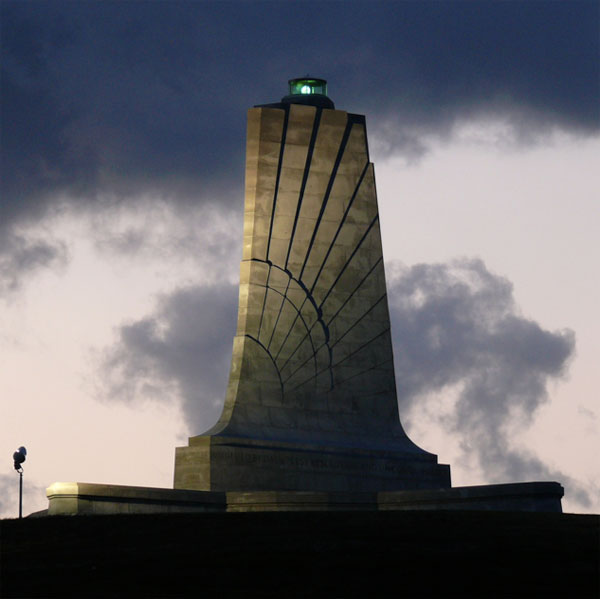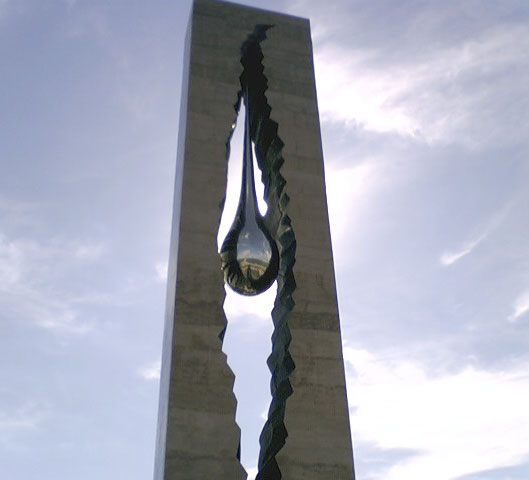Postscript to 9/11
by Roger Kaza
Today, is technology neutral? The University of Houston presents this program about the machines that make our civilization run, and the people whose ingenuity created them.
Last summer my family and I visited the Wright Brothers National Monument in Kitty Hawk, North Carolina. At Kill Devil Hill, a sixty-foot tower of Carolina granite commemorates the dream of powered flight, achieved here in 1903. But today, having just passed another anniversary of 9/11, the words 'tower' and 'flight' give us pause. 9/11 was a monstrous betrayal of the Wright brothers' triumph and the giddy century of commercial air travel that followed. Ordinary fanatics gained superhuman powers, which they used to homicidal ends on a scale we didn't, correction, we couldn't imagine. But surely, we say, the mere weapon of this crime — air technology — is a footnote to the larger story. The real questions are political, religious, cultural, take your pick. Technology, we're told, isn't good or evil. It's neutral. Who could possibly indict airplanes over the actions of a deranged few?

Wright Brothers Memorial, NC
Well, here's the problem: technology isn't neutral. It never has been. Its story means nothing without us. The first human tool we know of, the million-year-old Acheulean hand-axe, has hand as its middle name. All our technology connects to the human, whether we see it or not. And likewise everything we are plugs straight into our machines: our skills, our mistakes, our virtues, our vices, or, in the case of 9/11, our capacity for massive destruction and cruelty. Our machines represent us, they magnify us. They can't be neutral, since we're not neutral.
9/11 marked the first time in history that Air Traffic Control exercised the so-called ATC Zero order'all planes grounded. But let's step back. The first airplane casualty happened in 1908 when Orville Wright took Lieutenant Thomas Selfridge on a test flight. The plane crashed and Selfridge broke his skull. Shortly thereafter all Army pilots wore heavy headgear. That was our first fix. You can think of a million sequels: seatbelts, oxygen masks, runway lights, etc. etc. A spate of hijackings in the 1970s introduced the first airport security screenings. But no one had ever committed suicidal attacks with planes, had they? Actually they had, many times, during World War II. We forgot. More fixes followed: armored cockpit doors, flight marshals. The lines, the scanners. Some remedies are a hundred years in the making.
Of course no fix is perfect, least of all when human ingenuity is pitted against a diabolical opponent. Every preventative measure is provisional, temporary, whether in computer hacking or hijacking. Is this depressing news? Not necessarily. There have been tens of millions of routine, successful commercial flights since the Wright brothers first powered off Kill Devil Hill. A tiny percentage of them have crashed, and four were turned into terrible human missiles on 9/11. Technology isn't neutral. There's no need to pretend it is. The mere numbers confirm that, with our flying machines at least, the good has overwhelmingly outweighed the bad.

Teardrop Memorial, by Zurab Tesereteli. Bayonne Peninsula, NJ. A gift from the Russian people on the fifth anniversary of 9/11.
I'm Roger Kaza, from the University of Houston, where we're interested in the way inventive minds work.
The concluding remarks are based on a risk/reward utilitarian calculus, which our society (and this author) readily embraces. Some, for example those who eschew flying, might question its essentially 'actuarial' premises, i.e. the decision to take extremely small yet concrete risks each time we fly. For more information, see extensive Wikipedia article on Air Safety. An interesting discussion of utilitarianism, especially as it relates to risk/cost is found in Michael Sandel's bestselling book, Justice: What's the Right Thing to Do?
For John Lienhard's take on the subject, see Engines No. 1187, Good/Bad: People/Machines
Info on the Wright Brothers Memorial.
Info on the 9/11 Memorial.
Wright Brothers Memorial photo by Ken Thomas. Teardrop Memorial photo by Vmondry. Photos courtesy Wiki Commons.
This episode was first aired on September 20th, 2011